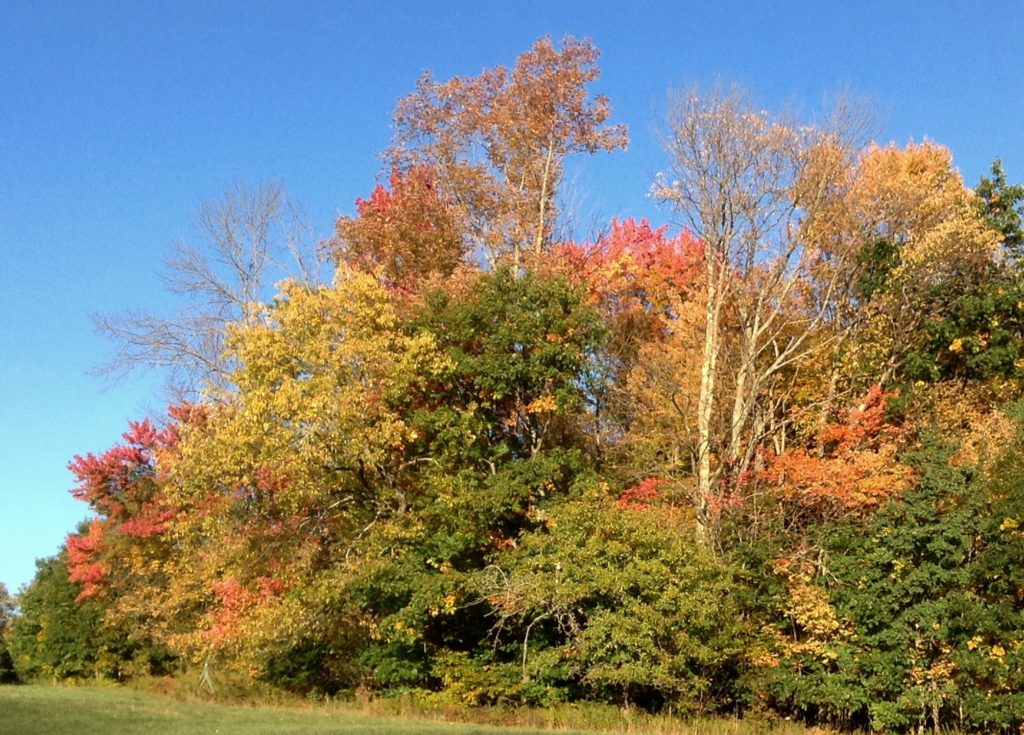 Can you tell a tree from its colors?
Can you tell a tree from its colors?
You can use fall leaf color to help identify different tree species. Look for these leaf colors on the trees in your neighborhood:
Oaks: red, brown or russet
Hickories: golden bronze
Dogwood: purple-red
Birch: bright yellow
paper birch
yellow birch
Poplar: golden yellow
Maple trees show a whole range of colors:
Sugar Maple: orange-red
Black Maple: glowing yellow
Red Maple: bright scarlet
Where do leaf colors come from?
Leaf color comes from pigments. Pigments are natural substances produced by leaf cells. The three pigments that color leaves are:
chlorophyll (green)
carotenoid (yellow, orange, and brown)
anthocyanin (red)
Chlorophyll is the most important of the three. Without the chlorophyll in leaves, trees wouldn’t be able to use sunlight to produce food.
Carotenoids create bright yellows and oranges in familiar fruits and vegetables. Corn, carrots, and bananas are just a few of the many plants colored by carotenoid.
Anthocyanins add the color red to plants, including cranberries, red apples, cherries, strawberries and others.
Chlorophyll and carotenoid are in leaf cells all the time during the growing season. But the chlorophyll covers the carotenoid — that’s why summer leaves are green, not yellow or orange. Most anthocyanins are produced only in autumn, and only under certain conditions. Not all trees can make anthocyanin.
How do leaves change color?
Leaf Graphic As the Earth makes its 365-day journey around the sun, some parts of the planet will get fewer hours of sunlight at certain times of the year. In those regions, the days become shorter and the nights get longer. The temperature slowly drops. Autumn comes, and then winter.
Trees respond to the decreasing amount of sunlight by producing less and less chlorophyll. Eventually, a tree stops producing chlorophyll. When that happens, the carotenoid already in the leaves can finally show through. The leaves become a bright rainbow of glowing yellows, sparkling oranges and warm browns. What about red leaves? Read on.
Do leaves change because of weather?
Perhaps you’ve noticed that in some years, the red fall colors seem brighter and more spectacular than in other years. The temperature and cloud cover can make a big difference in a tree’s red colors from year to year.
When a number of warm, sunny autumn days and cool but not freezing nights come one after the other, it’s going to be a good year for reds. In the daytime, the leaves can produce lots of sugar, but the cool night temperatures prevent the sugar sap from flowing through the leaf veins and down into the branches and trunk. Anthocyanins to the rescue! Researchers have found out that anthocyanins are produced as a form of protection. They allow the plant to recover nutrients in the leaves before they fall off. This helps make sure that the tree will be ready for the next growing season. Anthocyanins give leaves their bright, brilliant shades of red, purple and crimson.
The yellow, gold and orange colors created by carotenoid remain fairly constant from year to year. That’s because carotenoids are always present in leaves and the amount does not change in response to weather.
The amount of rain in a year also affects autumn leaf color. A severe drought can delay the arrival of fall colors by a few weeks. A warm, wet period during fall will lower the intensity, or brightness, of autumn colors. A severe frost will kill the leaves, turning them brown and causing them to drop early. The best autumn colors come when there’s been:
a warm, wet spring
a summer that’s not too hot or dry, and
a fall with plenty of warm sunny days and cool nights.
The above info came from: http://dnr.wi.gov/eek/veg/trees/treestruecolor.htm
